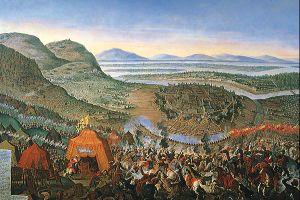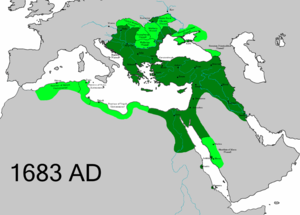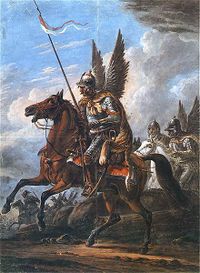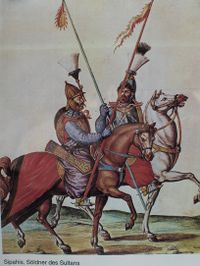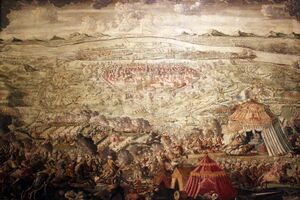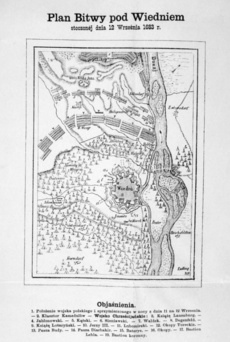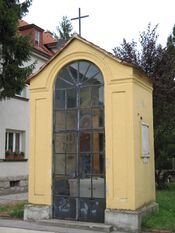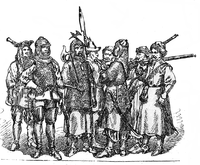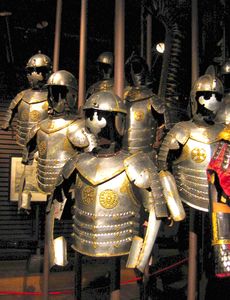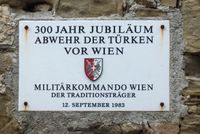معركة ڤيينا
| ||||||||||||||||||||||||||||||||
معركة ڤيينا (بالألمانية: Schlacht am Kahlenberg، بالپولندية: Bitwa pod Wiedniem أو Odsiecz Wiedeńska، بالتركية: İkinci Viyana Kuşatması, بالاوكرانية: Віденська відсіч / Viděns'ka Vidsič، وبالإنگليزية: Battle of Vienna) وقعت في 11 و12 سبتمبر[18] 1683 وبعد محاصرة الإمبراطورية العثمانية فيينا لمدة شهرين. كسرت المعركة اسبقية الدولة العثمانية في أوروبا، وإيذانا بالهيمنة السياسية من سلالة هابسبورگ النمساوية (تشمل أيضا بوهيميا والمجر) في وسط أوروبا.
مثلت معركة فيينا بداية النهاية لسيطرة الإمبراطورية العثمانية وتوسعاتها في جنوب الشرق الأوروبي. فاز بالمعركة القوات الپولندية-الألمانية - النمساوية بقيادة ملك بولندا يوحنا الثالث سوبياسكي ضد جيش الدولة العثمانية بقيادة الصدر الأعظم (الوزير) قرة مصطفى قائد القوات العثمانية[19].
The battle was won by the combined forces of the Holy Roman Empire and the Polish–Lithuanian Commonwealth, the latter represented only by the forces of the Crown of the Kingdom of Poland (the march of the Lithuanian army was delayed, and they reached Vienna after it had been relieved).[20] The Viennese garrison was led by Feldzeugmeister of the Imperial Army (Holy Roman Empire) Ernst Rüdiger Graf von Starhemberg, an Austrian subject of Holy Roman Emperor Leopold I. The overall command was held by the senior leader, the king of Poland, John III Sobieski, who led the relief forces.
The opposing military forces were those of the Ottoman Empire and its vassal states, commanded by Grand Vizier Merzifonlu Kara Mustafa Pasha. The Ottoman army numbered approximately 90,000[7] to 300,000[12][13][14][15] men (according to documents on the order of battle found in Kara Mustafa's tent, initial strength at the start of the campaign was 170,000 men[11]). They began the siege on 14 July 1683. Ottoman forces consisted, among other units, of 60 ortas of Janissaries (12,000 men paper-strength) with an observation army of some 70,000[21] men watching the countryside. The decisive battle took place on 12 September, after the arrival of the united relief army.
Some historians maintain that the battle marked a turning point in the Ottoman–Habsburg wars, a 300-year struggle between the Holy Roman and Ottoman Empires. During the 16 years following the battle, the Austrian Habsburgs would gradually conquer southern Hungary and Transylvania, largely clearing them of Ottoman forces. The battle is noted for including the largest known cavalry charge in history.
الافتتاحية
Capturing the city of Vienna had long been a strategic aspiration of the Ottoman Empire, due to the control the city had over the Danube and the overland trade routes to Germany and the Eastern Mediterranean. During the years preceding the siege, the Ottoman Empire, under the auspices of the Grand Vizier Kara Mustafa Pasha, undertook extensive logistical preparations, including the repair and establishment of roads and bridges leading into the Holy Roman Empire and its logistical centers, as well as the forwarding of ammunition, cannon, and other resources from all over the Empire to these centers and into the Balkans. The Siege of Szigetvár in 1566 blocked the advance of Sultan Suleiman the Magnificent's towards Vienna and stopped the Ottoman advance towards Vienna that year. Vienna was not threatened again until 1683. In 1679 plague had been raging in Vienna.[22]
On the political front, the Ottoman Empire had been providing military assistance to the Hungarians and non-Catholic minorities in Habsburg-occupied portions of Hungary. There, in the years preceding the siege, widespread unrest had grown into open rebellion against Leopold I's pursuit of Counter-Reformation principles and his desire to suppress Protestantism. In 1681, Protestants and other anti-Habsburg Kuruc forces, led by Imre Thököly, were reinforced with a significant military contingent from the Ottomans,[16] who recognized Thököly as King of "Upper Hungary" (the eastern part of modern-day Slovakia and parts of northeastern Hungary, which he had earlier taken by force from the Habsburgs). This support included explicitly promising the "Kingdom of Vienna" to the Hungarians if it fell into Ottoman hands. Yet before the siege, a state of peace had existed for 20 years between the Holy Roman Empire and the Ottoman Empire as a result of the Peace of Vasvár.
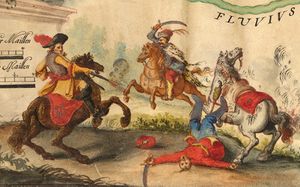
In 1681 and 1682, clashes between the forces of Imre Thököly and the Holy Roman Empire (the border of which was then northern Hungary) intensified, and the incursions of Habsburg forces into central Hungary provided the crucial argument of Grand Vizier Kara Mustafa Pasha in convincing Sultan Mehmed IV and his Divan to allow the movement of the Ottoman army. Mehmed IV authorized Mustafa Pasha to operate as far as Győr (then known as Yanıkkale, and in German as Raab) and Komárom (in Turkish Komaron, Komorn in German) Castles, both in northwestern Hungary, and to besiege them. The Ottoman army was mobilized on 21 January 1682 and war was declared on 6 August 1682.
Logistically, it would have been risky or impossible to launch an invasion in August or September 1682, since a three-month campaign would have taken the Ottomans to Vienna just as winter set in. But the 15-month gap between mobilization and the launch of a full-scale invasion provided ample time for Vienna to prepare its defense and for Leopold to assemble troops from the Holy Roman Empire and form an alliance with Poland, Venice and Pope Innocent XI. The defensive alliance of the Holy Roman Empire with Poland was concluded in the 1683 Treaty of Warsaw, by which Leopold promised to support John III Sobieski if the Ottomans attacked Kraków, and in return, the Polish army would come to the relief of Vienna if it were attacked.[16]
On 31 March, another declaration – sent by Grand Vizier Merzifonlu Kara Mustafa Pasha on behalf of Mehmed IV – arrived at the Imperial Court in Vienna. The next day the forward march of Ottoman army elements began from Edirne in Rumelia. Ottoman troops reached Belgrade by early May. They were joined by a Transylvanian army under Prince Mihaly Apafi and a Hungarian force under Imre Thököly; they laid siege to Győr and the remaining army of 150,000 moved toward the city of Vienna.[16] About 40,000 Crimean Tatar troops arrived 40 كيلومتر (25 mi) east of Vienna on 7 July,[16] twice as many as the Imperial troops in the area. Emperor Leopold fled Vienna for Passau with his court and 60,000 Viennese, while Charles V, Duke of Lorraine, withdrew his force of 20,000 towards Linz.[23][16] The main Ottoman army arrived at Vienna on 14 July; the city's only defense force was now that of Count Ernst Rüdiger von Starhemberg's 15,000 men.[16] Saxon engineer Georg Rimpler, who had been employed by the empire to prepare for war with the Turks, began to prepare Vienna for the upcoming siege – much of Austria's pre-war plans had calculated on fighting the Turks near the city of Győr, a plan made untenable by the Turkish advance.[24][25]
The King of Poland, John III Sobieski, prepared a relief expedition to Vienna during the summer of 1683, honoring his obligations to the treaty, and would depart from Kraków on 15 August. During this time most of Poland would be largely undefended, and taking advantage of the situation, Imre Thököly would attempt an invasion. Kazimierz Jan Sapieha delayed the march of the Lithuanian army, campaigning in the Hungarian Highlands instead, and arrived in Vienna only after it had been relieved.[20]
Immediately, tensions rose between Poland and the various German states – especially Austria – over the relief of the city. Payment of troops' wages and supplies while marching would be the predominant issue. Sobieski insisted that he should not have to pay for his march to Vienna, since it was by his efforts that the city had been saved; nor could the Viennese neglect the other German troops who had marched. The Habsburg leadership found as much money as possible to pay for these and arranged deals with the Polish to limit their costs.[26]
| القوات | المشاة | الفرسان والعربات | المدافع | الإجمالي |
|---|---|---|---|---|
| 29,600 | 17,800 | 124 | 47,250 | |
| |
8,100 | 10,350 | 70 | 18,400 |
| |
7,500 | 3,000 | 26 | 10,500 |
| |
7,000 | 2,500 | 12 | 9,500 |
| |
7,000 | 2,000 | 16 | 9,000 |
| 16,450 | 20,550 | 28 | 37,000[27] | |
| الهابسبورگ واتحادييهم يُقدروا بإجمالي: | 46,050 | 38,350 | 152 | 84,400 |
أحداث أثناء الحصار
The main Ottoman army laid siege to Vienna on 14 July. On the same day, Kara Mustafa sent the traditional demand that the city surrender to the Ottoman Empire.[Note 3] Ernst Rüdiger Graf von Starhemberg, leader of the remaining 15,000 troops and 8,700 volunteers with 370 cannons, refused to capitulate. Only days before, he had received news of the mass slaughter at Perchtoldsdorf,[28] a town south of Vienna, where the citizens had handed over the keys of the city after having been given a similar choice but were killed anyway. Siege operations started on 17 July.[16]
The Viennese had demolished many of the houses around the city walls and cleared the debris, leaving an empty plain that would expose the Ottomans to defensive fire if they tried to rush into the city.[16] In response to this Kara Mustafa Pasha would order his forces to dig long lines of trenches directly toward the city, to help protect them from the defenders as they advanced.
The Ottomans had 130 field guns and 19 medium-caliber cannon, compared to the defenders' 370.[7] Mining tunnels were dug under the city walls, which would then be filled with sufficient quantities of black powder to demolish the walls.[29][16] According to Andrew Wheatcroft, the outer palisade was around 150 years old and mostly rotten. To counter this, the defenders set to work knocking very large tree trunks into the ground to surround the walls. This disrupted the Ottoman plan of a quick siege, adding almost another three weeks to the time it would take to get past the old palisade.[30] This, combined with the delay in advancing their army after declaring war, eventually allowed a relief force to arrive in September.[16] Some historians have speculated that Kara Mustafa wanted to take the city intact with its riches and declined an all-out attack, not wishing to initiate the plundering that would accompany an assault, which was viewed as the right of conquering soldiers.[31]
The Ottoman siege cut virtually all means of food supply into Vienna.[32] Fatigue became so common that von Starhemberg ordered any soldier found asleep on watch to be shot. Increasingly desperate, the forces holding Vienna were on the verge of defeat when, in August, Imperial forces under Charles V, Duke of Lorraine, defeated Thököly at Bisamberg, 5 km (3.1 mi) northwest of Vienna.
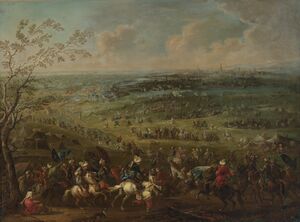
On 6 September, the Poles under Sobieski crossed the Danube 30 km (19 mi) northwest of Vienna at Tulln, to unite with imperial troops and the additional forces from Saxony, Bavaria, Baden and other imperial estates. The forces were also joined by several mercenary regiments of Zaporozhian Cossacks hired by the Polish–Lithuanian Commonwealth.[33] Louis XIV of France declined to help his Habsburg rival, having just annexed Alsace.[29]
An alliance between Sobieski and Emperor Leopold I resulted in the addition of the Polish hussars to the existing allied army. The command of the European allied forces was assigned to the Polish king, renowned for his extensive experience in leading campaigns against the Ottoman army. Notably, he achieved a decisive victory over the Ottoman forces in the Battle of Khotyn (1673) and now commanded an army of 70,000–80,000 soldiers, countering a supposed Ottoman force of 150,000.[16] Sobieski's courage and aptitude for command were already known in Europe.[بحاجة لمصدر]
During early September, approximately 5,000 experienced Ottoman sappers had repeatedly demolished large portions of the walls between the Burg bastion, the Löbel bastion and the Burg ravelin, creating gaps of about 12 متر (39 ft) in width. In response to this, the Viennese began digging their own tunnels to intercept the placing of large amounts of gunpowder in the caverns. The Ottomans finally managed to occupy the Burg ravelin and the low wall nearby on 8 September. Anticipating a breach in the city walls, the remaining Viennese prepared to fight in the inner city.[29]
Ottoman casualties during the siege (17 July – 12 September 1683)
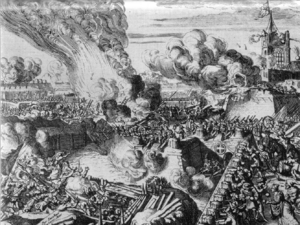
| Unit | Number |
|---|---|
| A. Kapıkulu (household) Army | 78,500 |
| Janissary and cebeci (weaponeer) and gunner | 60,000 |
| Sipâh (Kapıkulu) (household cavalry) | 15,000 |
| Mısır Kulu (Mamluks) | 3,000 |
| Şam Kulu (Damascus Mamluks) | 500 |
| B. Tımarlı Sipahiler (provincial cavalry) | 40,000 |
| C. Kapı Halkları (governor's retinue) | 44,200 |
| 8 viziers, three of them Tug-ed (banner) | 19,300 |
| Kara Mustafa Paşa | 6,000 |
| Janissary Agha Vizier Mustafa Pasha | 2,000 |
| D. Vassal States | 100,000 |
| Tatars | 50,000 |
| Wallachia | 10,000 |
| Moldavia | 10,000 |
| Transylvania | 10,000 |
| Middle Magyar (Thököly) | 20,000 |
| E. Rear Services | 170,000 |
| Clerk and janitor | 20,000 |
| Shepherd, animal driver, etc. | 150,000 |
| Total | 432,700 |
In this table, only household and retinue troops’ numbers are certain, 78,500 and 44,200 while other troops’ numbers are rounded, 50,000 Tatars, 10,000 Wallachian, 170,000 rear service etc. Based on this, Kahraman Şakul claim that this anonymous table show counted numbers of household and retinue troops while number of provincial troops (Tımarlı Sipahi: 40,000) and vassal states’ troops (100,000) is expected numbers. For instance, Tatars, Nogais and Circassians number was more than 100,000 while this table shows that Tatars (general term for Crimean Khanate and its vassals) brought 50,000 warriors.[35] Ottoman accounts state the size of the household army as 25,529 Janissaries, 3045 weaponeers (in Ottoman Turkish: cebeci) and 4000 gunners, totaling 32,574 as opposed to 60,000 estimation in this table. Therefore, according to K. Şakul's assessment, the Ottoman army consisted of approximately 120,000 soldiers and 156 guns. Within their ranks, 30,000 troops were strategically stationed in captured castles and deployed to disrupt the approaching relief army's movements.[36]
According to Austrian Ambassador Kunitz, the besieging Ottoman army had already decreased to 90,000 combatants as of 12 August. Kunitz also claimed that he learned from Ottoman captives that casualties were reaching 20,000 by end of August (other Austrian sources give Ottoman casualties as 12,000 until 13 August, demonstrating a steady increase in casualties of the Ottoman army in the days of siege[37]). An Ottoman account captured after battle recorded the number of casualties as 48,544 until 10 September: 10,000 janissary, 12,000 sipahi (elite heavy cavalry), 16,000 beldar (digger), 6,000 engineer (in Turkish lağımcı: miner), 2,000 provincial sipahi and 2,000 Tatars, totaling 48,544 deaths.[38] Compounding this, desertion (Ottoman sources and Luigi Marsigli give a 1/4 desertion of the Ottoman army[39]) and disease diminished the Ottoman army on a large scale. According to Ottoman sources, the number of soldiers decreased from 120,000 (according to Kunitz, the Ottoman army totalled 180,000 men and 1/3 of the army was stationed away from the siege[35]) to a warweary 40,000 soldiers. K. Şakul combines Kunitz's 90,000 combatant information for 12 August with an Ottoman casualties list, estimating the Ottoman army as 90,000 men (65,000 soldiers, around 60 guns and 25,000 rear service)[39] but Kunitz's 90,000 combatant information belongs to 12 August while the Ottoman list is for 10 September.[38] The Ottoman vassals of Transylvania, Wallachia and Moldavia were assigned to hold bridges on key retreat routes, thus not participating in the battle. The Tatar vassals were expected to participate in battle by the Ottomans but the mostly irregular Tatar horsemen demonstrated little effectiveness in battle, dissimilar to previous engagements. A lone 28,400 to 50,000 Ottoman army would battle against the relief army consisting of 65,000 soldiers (68,000 misinformation is originated from counting the 3,000 Polish contingent twice joined to the relief army beforehand) with 165–200 guns.[40]
Staging the battle
In an effort to stop the siege, the relief army of Poles and Imperial forces would rush to prepare a response. Despite the multinational composition of the army and the short space of only six days, an effective leadership structure was established, centred around the king of Poland and his heavy cavalry (Polish Hussars). The Holy League settled the issue of payment by using all available funds from the government, loans from several wealthy bankers and noblemen and large sums of money from the Pope.[26] The Habsburgs and Poles also agreed that the Polish government would pay for its own troops while still in Poland, but that the Emperor would fund them once they crossed into imperial territory. However, the Emperor would recognize Sobieski's claim to first rights of plunder of the enemy camp in the event of a victory.[26][41]
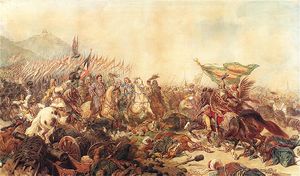
The combined besieging forces, led by Kara Mustafa, were less united and facing problems with motivation and loyalty, and struggled to prepare for the expected relief-army attack. Mustafa had entrusted defense of the rear to the Khan of Crimea and his cavalry force, which numbered between 30,000 and 40,000. There is doubt as to how much the Tatars participated in the final battle before Vienna. Their Khan refused to attack the relief force as it crossed the Danube on pontoon bridges and also refused to attack them as they emerged from the Vienna Woods. The Ottoman allies of Wallachia and Moldavia would also prove unreliable. George Ducas, Prince of Moldavia, was captured.[25] Șerban Cantacuzino, who sympathized with the Christian Coalition,[42] joined the retreat after Sobieski's cavalry charge.[25] Cantacuzino had negotiated with the Imperial forces for Wallachia to join the Christian side, longing for the position of protector of Christians in the Balkan Peninsula. In turn, the Habsburgs promised him the throne of Constantinople which was the capital of the Ottoman Empire.[43]
The confederated troops signalled their arrival on the Kahlenberg above Vienna with bonfires. The forces in the city of Vienna responded by sending Jerzy Franciszek Kulczycki, a Polish nobleman, diplomat and trader fluent in Turkish, on a successful spy mission to penetrate the Turkish forces and notify the relief troops of when the joint attack was to be made.[25]
Battle
The battle started before all units were fully deployed. At 4:00 am on 12 September, the Ottoman army attacked, seeking to interfere with the deployment of Holy League troops.[16] The Germans would be the first to counterattack. Charles of Lorraine moved forward with the imperial army on the left and other imperial forces in the center and, after heavy fighting and multiple Ottoman counterattacks, took several key positions, in particular the fortified villages of Nussdorf and Heiligenstadt. By midday, the imperial army had inflicted significant damage on the Ottoman forces and would come close to a breakthrough.[44] At the same time, Cantacuzino and his soldiers (who secretly supported the Christian coalition) were trying to sabotage the Ottoman siege, by abandoning the bridge over the Danube on Brigittenau Island, where the Wallachians had been stationed in order to cover the left flank of the Ottoman Army.[43] Mustafa Pasha launched counterattacks with most of his forces, but held back some of the elite Janissary and Sipahi units for a simultaneous assault on the city. The Ottoman leadership had planned, but ultimately failed, to capture Vienna prior to the arrival of Sobieski's forces. Their sappers had prepared a large, final detonation under the Löbelbastei[45] to breach the walls. In total, ten mines were set to explode but they were located by the defenders and disarmed.

In the early afternoon, a large engagement started on the other side of the battlefield as the Polish infantry advanced on the Ottoman right flank. Despite the arrival of the relief army, several Ottoman forces persisted in their attempts to breach the city's defenses, allowing Polish troops to advance on the field. By 4:00 pm the Poles had captured the village of Gersthof, which would serve as a base for their cavalry charge.[9] The Ottoman army was in a desperate position between Polish and Imperial forces. Charles of Lorraine and John III Sobieski both decided independently to press the offensive and decisively defeat the Ottoman forces.[46]
The German forces resumed the offensive on the left front at 3:30 pm. At first, they encountered fierce resistance and were unable to make progress. However, by 5:00 pm they had begun to advance and taken the villages of Unterdöbling and Oberdöbling. Imperial forces were now closing in on the central Ottoman position (the "Türkenschanze"),[46] and as they made preparations for a final push, the Polish cavalry began to take action.[25]
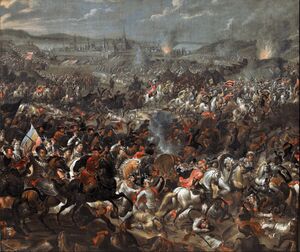
It is recorded that the Polish cavalry slowly emerged from a nearby forest to the cheers of onlooking infantry, which had been anticipating their arrival. At 4:00 pm, a detachment of 120 hussars engaged in a probing charge, successfully proving Ottoman vulnerability to attack but taking many casualties. During this action they would begin to approach the Türkenschanze, which was now threatened by three separate forces (the Poles from the west, the Saxons and Bavarians from the northwest and the Austrians from the north). At this point, the Ottoman vizier decided to leave this position and retreat to his headquarters in the main camp further south. However, by then many Ottoman soldiers were already leaving the battlefield.[9]
The relief army was now ready for a final push. At around 6:00 pm, the Polish king ordered the cavalry to attack in four contingents, three Polish groups and one from the Holy Roman Empire. 18,000 horsemen charged down the hills, the largest cavalry charge in history.[47][48] Sobieski led the charge[16] at the head of 3,000 Polish heavy lancers, the "Winged Hussars". Lipka Tatars who participated on the Polish side wore a sprig of straw in their helmets to distinguish them from the tatars fighting on the Ottoman side.[49] The charge quickly broke the battle lines of the Ottomans, who were already exhausted and demoralized and would begin to retreat from the battlefield. The cavalry headed directly towards the Ottoman camps and Kara Mustafa's headquarters, while the remaining Viennese garrison sallied out of its defenses to join in the assault.[16]
The Ottoman forces were tired and dispirited following the failure of the sapping attempt, the assault on the city and the advance of the Holy League infantry on the Türkenschanze.[16] Less than three hours after the decisive cavalry charge, the Holy League forces had won the battle and successfully defended Vienna. The first Catholic officer who entered the city was Louis William, Margrave of Baden-Baden, at the head of his dragoons.[9] Afterwards Sobieski paraphrased Julius Caesar's famous quotation (Veni, vidi, vici) by saying "Venimus, vidimus, Deus vicit"- "We came, we saw, God conquered".[16][25]
العثمانيون وڤيينا
احتلال فيينا كان حلماً طالما راود سلاطين العثمانيين لما تمثله من أهمية استراتيجية للسيطرة على خطوط التجارة والمواصلات في القلب الأوروبي وأعقبت معركة فيينا الحصار الثاني الذي شهدته فيينا من قِبل الأتراك. كان العثمانيون في كل مرة يكتفون بالعودة من أسوار فيينا غانمين الأموال وربما أجزاء جديدة من أوروبا الشرقية أو الوسطى بموجب اتفاقات مع الإمبراطورية النمساوية [19]. الحصار الأول كان في زمان سليمان القانوني قبلها بقرن ونصف والذي توغل في أوروبا بعدما انتصر على المجريين في معركة موهاج الرهيبة. دخلت جيوش القانوني عاصمة المجر بودابست في الحادي عشر من سبتمبر 1526 لتجعل من (مجرستان) ولاية عثمانية أخرى وتكرس السيطرة المطلقة للعثمانيين في وسط وشرق أوروبا. إلى أن كانت معركة فيينا في نفس اليوم بالضبط بعدها بـ 157 سنة[50].
الثورة البوهيمية
في عام 1618 اندلعت الثورة البوهيمية ضد إمبراطورية الهابسبورج والتي عرفت بحرب الثلاثين عاماً لأنها دامت إلى عام 1648 وانتهت بمعاهدة فيستفال في عهد فرديناند الثالث.
في عام 1683 حاصر الأتراك فيينا للمرة الثانية ولكن استطاع جراف شتارهمبرج في معركة عند جبل الكالينبرج رد الأتراك. وفي عام 1686 استردوا بودابست من الدولة العثمانية بعد 145 عام من السيطرة العثمانية على بودابست
المعركة
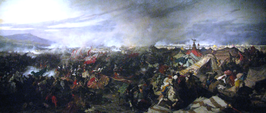
الحصار نفسه بدأ في 14 يوليو 1683 دون أن يعلم السلطان محمد الرابع بتوجيه حملته إلى فيينا، وأبلغه بذلك الأمر مصطفى باشا بعد بدء الحصار بستة أيام، جيش الامبراطورية العثمانية ما يقرب من 138000 من الرجال (رغم أن عددا كبيرا منهم لم يشترك في المعركة، حيث لم تتجاوز 50000 وشهدت الجنود (الاتراك)، وكان الباقي من القوات الداعمة)،. المعركة الحاسمة وقعت في 12 ايلول / سبتمبر 1683.
القوات المتحدة البولندية - الألمانية - النمساوية من الجيش وصلت إلى 70000 رجل.
- 30000 - رجل القوات البولندية (ولم يشارك الليتوانيين في المعركة)، # 18,500 القوات النمساوية بقيادة شارل الخامس، دوق اللورين، # 19,000، مواطن من سوابيا البافاري والقوات التي يقودها الأمير جورج فريدريك من Waldeck، # 9,000 جندي بقيادة جون جورج الثالث، للناخب في سكسونيا.
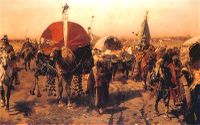
بدأت الحملة الأخيرة نحو فيينا عام 1663 عندما تقدم جيش كبير، يبلغ نحو مائة وعشرين ألف جندي، ومزود بالمدافع والذخائر المحملة على ستين ألف جمل وعشرة آلاف بغل، ودخل (سلوفاكيا) ضاربًا كل الاستحكامات العسكرية التي كانت في طريقه، متجهًا إلى قلعة (نوهزل) Érsekújvár ، وهي تقع شمال غرب (بودابست)، على الشرق من (فيينا) بنحو 110 كم، ومن براتسلاڤا بنحو 80 كم، وقد حصّنها الألمان، وجعلوها فائقة الاستحكام لكي تصبح أقوى قلاع أوروبا، وبدأ الجيش العثماني في حصارها في 17 أغسطس 1663 واستمر حصار العثمانيين للقلعة 37 يومًا؛ ما اضطر قائد حامية القلعة إلى طلب الاستسلام، ووافق الصدر الأعظم على ذلك؛ بشرط جلاء الحامية عن القلعة بغير سلاح ولا ذخائر.
مجلس الحرب
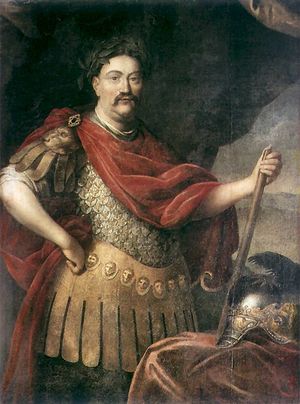
جمع الصدر الأعظم قرة مصطفى باشا مجلس الحرب في جيشه وأعلن أنه سيستولي على فيينا، وأنه سيملي شروطه على ألمانيا في هذه المدينة العنيدة (فيينا)؛ لأن الاستيلاء على "يانق قلعة" المدينة التي تعتبر مفتاح فيينا وتقع على بعد 80 كم شرقي فيينا على الضفة الغربية لنهر راب، لا يمكن أن يخضع ألمانيا ويجعلها تكف يدها عن شئون المجر.
أثار قرار قرة مصطفى باشا حيرة الوزراء وجدلهم، واعترض عليه الوزير إبراهيم باشا الذي أكد أن رغبة السلطان هي الاستيلاء على "يانق قلعة" ومناوشة أوروبا الوسطى بواسطة كتائب الصاعقة العثمانية، وأن الحملة على فيينا يحتمل أن تكون في العام المقبل، فأجابه قرة مصطفى باشا بأنه من الصعب أن يتجمع جيش مرة ثانية بمثل هذه الكثافة والقوة، وهذا الأمر يقتضي إنزال ضربة قوية قاضية بالألمان، وإلا فإن الحرب ستطول معهم، خاصة أن ألمانيا عقدت صلحا مع فرنسا، وأصبحت آمنة من الجانب الغربي، وأن الإمبراطور "ليوبولد" اتفق مع الملك البولوني "سوبياسكي" على استعادة منطقة بادوليا، وأن البندقية لا بد أن تكون ضمن هذا الاتفاق، وبالتالي ستنضم روسيا وبقية الدول الأوروبية لهذا التحالف المسيحي إلى جانب ألمانيا، وهذا يقتضي كسره وتحطيم هذا التحالف الوليد في ذلك العام وإلا فإن الحرب ستطول إلى أجل غير معلوم[51].
باتت (فيينا) عاصمة النمسا مهددة بالسقوط في أيدي المسلمين؛ ما دعا إمبراطور النمسا إلى طلب وساطة البابا (اینوسنت الحادي عشر) لدى (لويس الرابع عشر)، ملك فرنسا بقصد مساعدته، وكانت فرنسا أكبر أعداء إمبراطور النمسا؛ فأرسل له ملك فرنسا فرقة ممتازة مؤلفة من 5000 جندي. غير أن العثمانيين واصلوا تقدمهم ودارت بينهما عدة معارك. انتهت بتوقيع معاهدة صلح بين الدولتين، كان من أهم بنودها أن تدفع النمسا للعثمانيين غرامات حرب رمزية، قدرها 200000 سكة ذهبية، وأن تبقى كافة القلاع التي فتحتها الجيوش العثمانية تحت سيادتهم.
عندما التأمت الجيوش الأوروبية ترك دوق لورين القيادة العامة لملك بولندا يوحنا الثالث سوبياسكي واكتملت استعداداتهم يوم الجمعة الموافق 11 سبتمبر بعدما شعروا أن سقوط فيينا ليس أمامه إلا أيام قليلة؛ لذلك أقدم الأوروبيون على عبور جسر "الدونة" الذي يسيطر عليه العثمانيون بالقوة مهما كلفهم من خسائر، حيث لم يكن بالإمكان إيصال الإمدادات إلى فيينا دون عبور هذا الجسر. وكان مصطفى باشا قد كلف "مراد كيراي" حاكم القرم في الجيش بمهمة حراسة الجسر، ونسفه عند الضرورة وعدم السماح للأوروبيين بعبوره مهما كانت الأمور، وقد كان مصطفى باشا يكره مراد كيراي، ويعامله معاملة سيئة، أما مراد فكان يعتقد أن فشل مصطفى باشا في فيينا سيسقطه من السلطة ومن منصب الصدارة، ولم يخطر ببال هذا القائد الخائن أن خسارة العثمانيين أمام فيينا ستغير مجرى التاريخ العالمي، لذلك قرر مراد أن يظل متفرجا على عبور القوات الأوروبية جسر الدونة، ليفكوا الحصار المفروض على فيينا، دون أن يحرك ساكنا، يضاف إلى ذلك أن هناك وزراء وبكوات في الجيش العثماني كانوا لا يرغبون في أن يكون قرة مصطفى باشا هو فاتح فيينا التي فشل أمامها السلطان سليمان القانوني.
المعركة الفاصلة
في يوم السبت 12 سبتمبر 1683 تقابل الجيشان أمام أسوار فيينا وكان الأوروبيون فرحين لعبورهم جسر الدونة دون أن تُسكب منهم قطرة دم واحدة، إلا أن هذا الأمر جعلهم على حذر شديد، أما العثمانيون فكانوا في حالة من السأم لعدم تمكنهم من فتح فيينا، وحالة من الذهول لرؤيتهم الأوروبيين أمامهم بعد عبور جسر الدونة، بالإضافة إلى ما ارتكبوه من شرب الخمر ومعاشرة النساء، وانشغال بعض فرق الجيش بحماية غنائمها وليس القتال لتحقيق النصر، وتوترت العلاقة بين الصدر الأعظم وبعض قواد جيشه وظهرت نتائج ذلك مع بداية المعركة.
شن مصطفى باشا هجوما مضادا، مع معظم قواته، واجزاء من النخبه الانكشاريه لغزو المدينة. كان القواد الترك ينوون احتلال فيينا قبل وصول يوحنا الثالث سوبياسكي ولكن الوقت نفد. اعد المهندسون العسكريون تفجير آخر كبير ونهائي لتوفير إمكانية الوصول إلى المدينة. بينما انهى الأتراك على عجل عملهم واغلاق النفق لجعل الانفجار أكثر فعالية، اكتشف النمساويين الكهف في فترة ما بعد الظهر. احدهم دخل النفق وابطل مفعولها في الوقت المناسب تماما.
في ذلك الوقت، في ساحة المعركة ،بدأت المشاة البولندية الهجوم على الجهة اليمنى جيش الامبراطورية العثمانية وبدلا من التركيز على المعركة مع الجيش الاغاثة، حاولت قوة الأتراك احتلال المدينة.
كان الجيش العثماني متعبا ومتشائم بعد فشل كل محاولة استنزاف القوة الغاشمة واعتداء من المدينة، ووصول للسلاح الفرسان حول مجرى المعركة ضدهم، وارسالهم إلى التراجع إلى الجنوب والشرق. في اقل من ثلاث ساعات بعد هجوم سلاح الفرسان، كسبت القوى المسيحية المعركة وانقذت فيينا من الاحتلال. وبعد المعركة ،اقتبس يوحنا الثالث سوبياسكي واعاد صياغة يوليوس قيصر الشهيرة بالقول" veni، vidi، الآلة vicit "--" أتيت، رأيت، غزاها الرب ".
أهمية نتائج المعركة
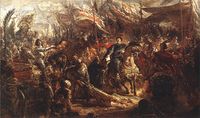
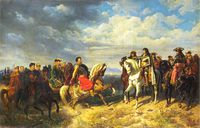
المعركة نقطة تحول في كفاح 300 سنة بين القوات من أوروبا الوسطى وممالك الامبراطورية العثمانية.وبعد المعركة على مدى ستة عشر عاما تمكنت سلالة عائلة هابسبورگ النمساوية تدريجيا إلى حد كبير اخلائ القوات التركية من الاراضى الجنوبية والمجر وترانسيلفانيا.
قُتل من العثمانيين حوالي 15000 رجل في القتال وقُتل من الأوروبيين ما يقرب من 4000 ووضع مصطفى باشا خطة موفقة للانسحاب حتى لا يضاعف خسائره، وأخذ الجيش العثماني معه أثناء الانسحاب 81 ألف أسير, وعلى الرغم من هزيمة القوات التركية الكاملة فقد وجدت الوقت لذبح جميع السجناء النمساويين، فيما عدا تلك القلة من طبقة النبلاء التي اخذوا معهم للافتداء. وانتهى الحصار الذي استمر 59 يوما.
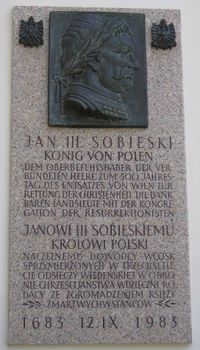
فقدت الدولة العثمانية بهزيمتها أمام فيينا ديناميكية الهجوم والتوسع في أوروبا، وكانت الهزيمة نقطة توقف في تاريخ الدولة. تحرك جيش التحالف المسيحي لاقتطاع بعض الأجزاء من الأملاك العثمانية في أوروبا، ووقعت معركة "جكردلن" بين أحد القادة العثمانيين وقواته البالغة 30 ألف مقاتل وبين ملك بولندا يوحنا الثالث سوبياسكي وقواته البالغة 60 ألف مقاتل، وانتهت بتراجع سوبياسكي، وتوالت المعارك العثمانية في أوروبا، وفقدت الدولة بعض مراكزها الهامة بسبب هزيمتها أمام فيينا التي كانت هزيمة من النوع الثقيل تاريخيا أكثر منه عسكريا.
انظر أيضاً
ملاحظات
- ^ Viennese garrison: 15,000 soldiers[6] + 8,700 volunteers,[7] 370 cannons; Relief force: 50,000–60,000 Germans,[8] 15,000–20,000 Poles[8][9]
- ^ The lowest estimate is 90,000,[7] while according to older estimates even up to 300,000[12][13][14][15]
- ^ The original document was destroyed during World War II. For the German translation, see here [1] Archived 29 مايو 2008 at the Wayback Machine
الهامش
- ^ خطأ استشهاد: وسم
<ref>غير صحيح؛ لا نص تم توفيره للمراجع المسماةFinkel - ^ أ ب ت Podhorodecki, Leszek (2001), Wiedeń 1683, Bellona, p. 83.
- ^ Podhorodecki, Leszek (2001), Wiedeń 1683, Bellona, p. 106.
- ^ Podhorodecki, Leszek (2001), Wiedeń 1683, Bellona, p. 105.
- ^ Podhorodecki, Leszek (2001), Wiedeń 1683, Bellona, pp. 83, 106.
- ^ Tucker, Spencer (2010). Battles That Changed History: An Encyclopedia of World Conflict. ABC-CLIO. p. 215.
- ^ أ ب ت ث ج ح Bruce Alan Masters, Gábor Ágoston: Encyclopedia of the Ottoman Empire, Infobase Publishing, 2009, ISBN 1438110251, 584.
- ^ أ ب Austria's Wars of Emergence, Michael Hochedlinger
- ^ أ ب ت ث The Enemy at the Gate, Andrew Wheatcroft. 2008.
- ^ Forst de Battaglia, Otto (1982), Jan Sobieski, Mit Habsburg gegen die Türken, Styria Vlg. Graz, p. 215 of 1983 Polish translated edition.
- ^ أ ب Wimmer, Jan (1983), Wiedeń 1683, MON, p. 306.
- ^ أ ب Harbottle, Thomas (1905), Dictionary of Battles, E.P. Sutton & Co, p. 262.
- ^ أ ب Clare, Israel (1876), The Centennial Universal History: A Clear and Concise History of All Nations, with a Full History of the United States to the Close of the First 100 Years of Our National Independence., J. C. McCurdy & Co., p. 252.
- ^ أ ب Drane, Augusta (1858), The Knights of st. John: with The battle of Lepanto and Siege of Vienna., Burns and Lambert, p. 136.
- ^ أ ب American Architect and Building News. 29.767 (1890): 145. Print.
- ^ أ ب ت ث ج ح خ د ذ ر ز س ش ص ض ط ظ ع غ Tucker, Spencer (2010). A Global Chronology of Conflict. Vol. Two. Santa Barbara: ABC-CLIO, LLC. ISBN 978-1851096671.
- ^ Podhorodecki, Leszek (2001), Wiedeń 1683, Bellona, pp. 140–41.
- ^ Date of Battle
- ^ أ ب Travel maktob
- ^ أ ب Davies, Norman (1982), God's Playground, a History of Poland: The Origins to 1795, Columbia University Press, p. 487
- ^ Bruce, George (1981). Harbottle's Dictionary of Battles. Van Nostrand Reinhold.
- ^ Nähere Untersuchung der Pestansteckung, p. 42, Pascal Joseph von Ferro, Joseph Edler von Kurzbek, royal publisher, Vienna 1787.
- ^ Andrew Wheatcroft (2009). The Enemy at the Gate: Habsburgs, Ottomans and the Battle for Europe. Random House. p. 120. ISBN 978-1-4090-8682-6.
- ^ Duffy, Christopher (2015). The Fortress in the Age of Vauban and Frederick the Great 1660–1789 (in الإنجليزية). Routledge. ISBN 978-1-317-40859-8.
- ^ أ ب ت ث ج ح Ekkehard Eickhoff; Rudolf Eickhoff (2009). Venedig, Wien und die Osmanen: Umbruch in Südosteuropa 1645–1700. Klett-Cotta. p. 354. ISBN 978-3-608-94511-9.
- ^ أ ب ت Stoye, John. The Siege of Vienna: The Last Great Trial between Cross & Crescent. 2011 قالب:ISBN?[صفحة مطلوبة]
- ^ Exact Polish Order of Battle and Strength Reports as of 1 August 1683
- ^ Palmer, Alan, The Decline and Fall of the Ottoman Empire, p. 12, Barnes & Noble Publishing, 1992. ISBN 1-56619-847-X
- ^ أ ب ت Michael Gaitley, MIC (2015). The Second Greatest Story Ever Told. Marian Press – Association of Marian Helpers. pp. 33–. ISBN 978-1-59614-319-7.
- ^ "The Siege of Vienna". Melvyn Bragg, Andrew Wheatcroft, Dr. Claire Norton and Jeremy Black (historian). In Our Time. 14 May 2009. 17:30 minutes in.
- ^ Bates, Brandon J. (2003). "The Beginning of the End: The Failure of the Siege of Vienna of 1683" (PDF). Brigham Young University. Archived from the original (PDF) on 22 August 2006. Retrieved 28 August 2006.
- ^ Ripperton, Lisa. "The Siege of Vienna". The Baldwin Project. Retrieved 28 August 2006.
- ^ "Hol Kulchitsky, a Ukrainian, Saved Vienna From Destruction in 1683" (PDF). Svoboda. 6 October 1933.
- ^ Kahraman Şakul. II. Viyana Kuşatması: Yedi Ejderin Fendi, Timaş Yayınları. İstanbul 2021. pp. 229–231.
- ^ أ ب Şakul, Kahraman (2021). II. Viyana Kuşatması Yedi Ejderin Fendi (in التركية). İstanbul: Timaş Publishing. p. 228. ISBN 978-6050835663.
- ^ Şakul, Kahraman (2021). II. Viyana Kuşatması Yedi Ejderin Fendi (in التركية). İstanbul: Timaş Publishing. pp. 232–233. ISBN 978-6050835663.
- ^ Şakul, Kahraman (2021). II. Viyana Kuşatması Yedi Ejderin Fendi (in التركية). İstanbul: Timaş Publishing. p. 302. ISBN 978-6050835663.
- ^ أ ب Şakul, Kahraman (2021). II. Vİyana Kuşatması Yedi Ejderin Fendi (in التركية). İstanbul: Timas Publishing. p. 391. ISBN 978-6050835663.
- ^ أ ب Şakul, Kahraman (2021). II. Vİyana Kuşatması Yedi Ejderin Fendi (in التركية). İstanbul: Timaş Publishing. p. 392. ISBN 978-6050835663.
- ^ Şakul, Kahraman (2021). II. Viyana Kuşatması Yedi Ejderin Fendi (in التركية). İstanbul: Timaş Publishing. p. 393. ISBN 978-6050835663.
- ^ Henry Elliot Malden (2014). Salus Vienna Tua: The great siege of 1683. Soldiershop Publishing. pp. 79–. ISBN 978-88-96519-84-4.
- ^ Ştefan Ştefănescu, "Defense of the Integrity of the Romanian States in the Sixteenth and Seventeenth Centuries", in Hie Ceausescu ed., War Revolution and Society in Romania the Road to Independence, New York, Social Science Monographs, Boulder, 1983, p. 76.
- ^ أ ب "Participarea lui Șerban Cantacuzino la cel de-al Doilea Asediul Vienei". Historia (in الرومانية).
- ^ Wheatcroft, Andrew (2008). The Enemy at the Gate, Preface p. xix, p. 1.
- ^ "Duell im Dunkeln" (in الألمانية). 2DF. 6 November 2005. Archived from the original on 29 September 2007. Retrieved 28 August 2006.
- ^ أ ب idem
- ^ A'Barrow, Stephen R (2016). Death of a Nation: A New History of Germany. Book Guild Publishing. p. 73. ISBN 978-1910508817.
- ^ Overy, Richard (2014). A History of War in 100 Battles. Oxford University Press. p. 58. ISBN 978-0199390717.
- ^ "The Battle of Vienna was not a fight between cross and crescent – Dag Herbjørnsrud | Aeon Essays". Aeon. Retrieved 20 June 2019.
- ^ أشرف إحسان فقيه
- ^ منتديات الجزائر للأبد
مراجع
- مقالات بالمعرفة بحاجة لذكر رقم الصفحة بالمصدر from September 2023
- CS1 التركية-language sources (tr)
- CS1 الرومانية-language sources (ro)
- CS1 الألمانية-language sources (de)
- Short description is different from Wikidata
- Articles with unsourced statements from May 2023
- Articles with hatnote templates targeting a nonexistent page
- Pages with empty portal template
- Austria articles missing geocoordinate data
- All articles needing coordinates
- تاريخ النمسا
- تاريخ مسيحي
- تاريخ إسلامي
- معارك الدولة العثمانية
- نزاعات 1683
- 1683 في النمسا
- معارك الحرب التركية الكبرى
- معارك پولندا
- التاريخ العسكري للنمسا
- تاريخ ڤيينا
- التاريخ العسكري لألمانيا
- حصارات الدولة العثمانية
- القرن 17 في الدولة العثمانية
